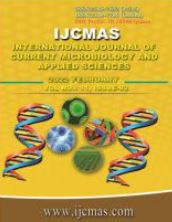


 National Academy of Agricultural Sciences (NAAS)
National Academy of Agricultural Sciences (NAAS)

|
PRINT ISSN : 2319-7692
Online ISSN : 2319-7706 Issues : 12 per year Publisher : Excellent Publishers Email : editorijcmas@gmail.com / submit@ijcmas.com Editor-in-chief: Dr.M.Prakash Index Copernicus ICV 2018: 95.39 NAAS RATING 2020: 5.38 |
Betelvine (Piper betle) is heart-shaped deep green leaves perennial plant an important cash crop of India for livelihood security in rural area particularly small as well as marginal betel growers of “baree community” in Maharashtra. The anthracnose leaf spot is the major constraint in production and market value of betel leaf production. A study was undertaken during two consecutive years (2019, 2020) the significant results were obtained in eight fungicides with respective commercial concentration tested against the Colletotrichum piparis leaf spot disease in betel vine. All treatment in the year 2019-20, 2020-21 are found statistically significant in reaction for mean % disease intensity and no. of leaves harvested (yield).For the year 2019-20 and 2020-21, mean % disease intensity the lowest was found in treatment T3 (Chlorothalonil@2.5 m/lit) i.e.4.83 and 4.93 respectively while they showing highest % disease control i.e. 49.68%and 43.59%.In year 2019 in respect of no. of leaves harvested (Yield) the treatment T 4 (Trichoderma spp. @ 5gm./lit.) giving significantly superior yield of leaves (1052) over rest of all the treatment. The treatment T3 (Chlorothalonil@2.5 m/lit.) with yield 952.00 found at par with it. In year 2020 the no. of leaves harvested (Yield) the treatment T 4 (Trichoderma spp. @ 5gm./lit.) giving significantly superior yield of leaves (1075) over rest of all the treatment. The treatment T3 (Chlorothalonil@2.5 m/lit.) with yield 963.00 and treatment T2 (Copper oxychloride +2 Chloro,2Bromo,1,3 diol (Bromopol))@ 2.5 g+0.5 g/lit. respectively with leaf yield 913.67 found at par with it.
 |
 |
 |
 |
 |